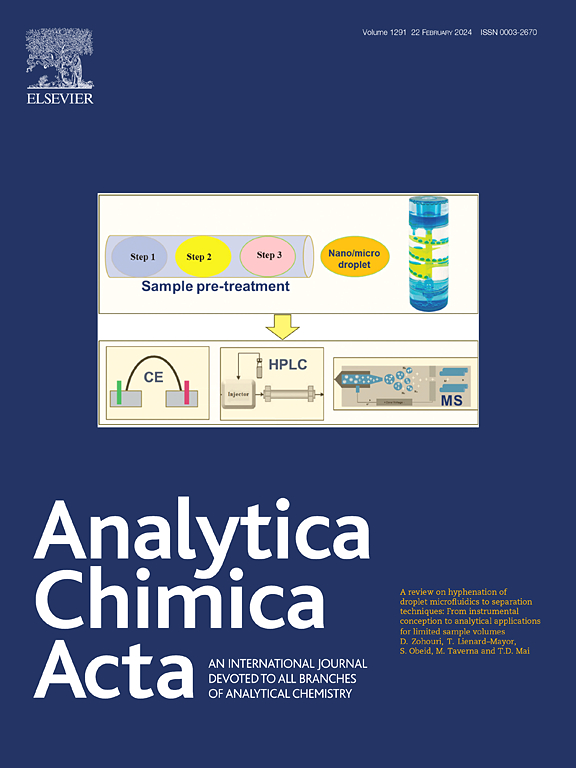使用多因子实验设计的液滴数字PCR系统的内部验证
IF 5.7
2区 化学
Q1 CHEMISTRY, ANALYTICAL
引用次数: 0
摘要
数字聚合酶链反应(digital polymerase chain reaction, dPCR)已成为核酸定量分析的重要技术,在食品和饲料安全分析中的应用日益增多。ISO/IEC 17025或ISO/IEC 15198等国际标准要求对方法进行适当的验证。在本研究中,开发了一种特定的dPCR系统验证和统计建模方法,并将其应用于Bio-Rad QX200液滴dPCR (ddPCR)系统。这种方法采用了析因实验设计,其基础统计模型反映了泊松过程控制测量机制。结果大多数实验因素,如操作人员、引物/探针系统和限制性内切酶的添加,对DNA拷贝数的定量没有相关影响,证实了该系统的稳健性。然而,ddPCR主混合物的选择和用于计算DNA拷贝浓度的液滴体积是关键因素。只有使用“Supermix for Probes (no dUTP)”才有可能在整个工作范围内确认ddPCR系统的准确性。结果表明,Bio-Rad QX200 ddPCR系统具有较高的精密度、灵敏度、均匀性和鲁棒性。此外,我们提出了如何增加稳定液滴的数量,从而提高统计计算的接受度的程序。数字PCR系统的内部验证和建模的新概念可转移到其他数字PCR技术。本文章由计算机程序翻译,如有差异,请以英文原文为准。

In-house validation of a droplet digital PCR system using a multifactorial experimental design
Background
Digital PCR (dPCR, digital polymerase chain reaction) has become an important technology for quantification of nucleic acids and its application in food and feed safety analysis is increasing. International standards such as ISO/IEC 17025 or ISO/IEC 15198 require an appropriate validation of the methods. In this study, a specific approach for the validation and statistical modelling of dPCR systems was developed and applied to the Bio-Rad QX200 Droplet dPCR (ddPCR) system. This approach uses a factorial experimental design and the underlying statistical model reflects the Poisson process governing the measurement mechanism.
Results
We show that most of the experimental factors tested, such as the operator, the primer/probe system and the addition of restriction enzymes, have no relevant effect on the quantification of DNA copy numbers, confirming the robustness of the system. However, the choice of the ddPCR master mix and the droplet volume used to calculate DNA copy concentrations are critical factors. Only with the “Supermix for Probes (no dUTP)” was it possible to confirm the accuracy of the ddPCR system over the entire working range.
Significance
High precision, sensitivity, uniformity and robustness of the Bio-Rad QX200 ddPCR system were demonstrated. In addition, we present procedures how to increase the number of stabilised droplets leading to improved acceptance for statistical calculations. The new concept for the in-house validation and modelling of digital PCR systems is transferable to other digital PCR technologies.
求助全文
通过发布文献求助,成功后即可免费获取论文全文。
去求助
来源期刊

Analytica Chimica Acta
化学-分析化学
CiteScore
10.40
自引率
6.50%
发文量
1081
审稿时长
38 days
期刊介绍:
Analytica Chimica Acta has an open access mirror journal Analytica Chimica Acta: X, sharing the same aims and scope, editorial team, submission system and rigorous peer review.
Analytica Chimica Acta provides a forum for the rapid publication of original research, and critical, comprehensive reviews dealing with all aspects of fundamental and applied modern analytical chemistry. The journal welcomes the submission of research papers which report studies concerning the development of new and significant analytical methodologies. In determining the suitability of submitted articles for publication, particular scrutiny will be placed on the degree of novelty and impact of the research and the extent to which it adds to the existing body of knowledge in analytical chemistry.
 求助内容:
求助内容: 应助结果提醒方式:
应助结果提醒方式:


